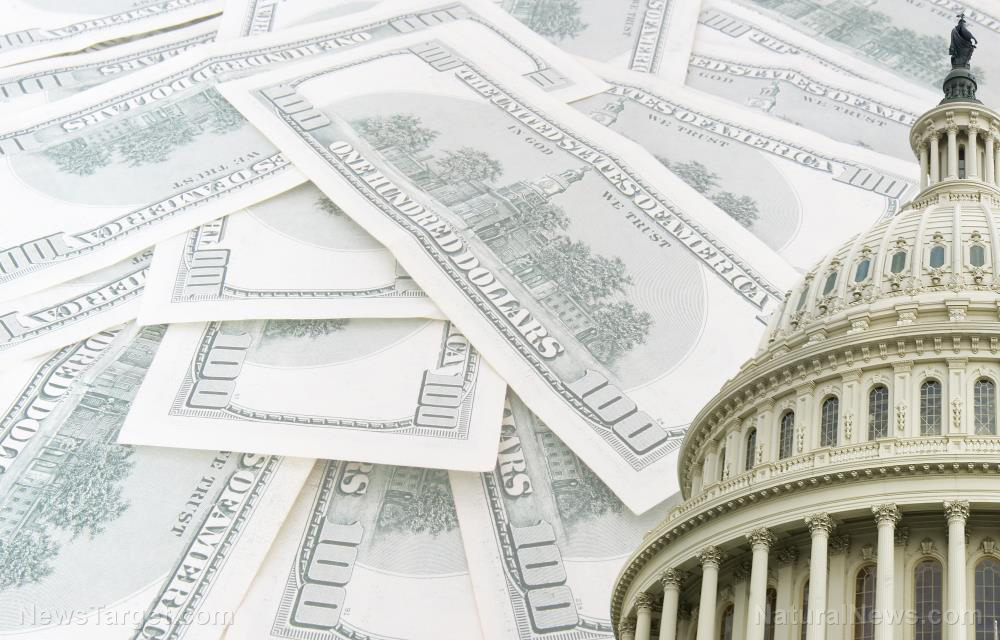DEBT BLOWOUT: US debt has soared $1.2T since debt ceiling suspension – and the Treasury expects to add another $1.5T by year’s end
08/03/2023 / By Arsenio Toledo

Since the suspension of the United States’ debt limit in early June, the government’s debt has spiked by almost $1.2 trillion to nearly $32.7 trillion. Worse yet, the Department of the Treasury expects another $1.5 trillion added to the national debt by the end of the year.
According to data from the Treasury Department, the total $32.66 trillion of government debt is composed of two different kinds of Treasury securities. Around $6.9 trillion of debt is in the form of nonmarketable Treasury securities purchased by U.S. government pension funds like the Social Security Trust Fund.
Meanwhile, the remaining $25.7 trillion is in the form of marketable securities, or Treasury securities that are held and traded by the global public, either by regular people purchasing government bonds or Big Banks and national banks purchasing them, like the Federal Reserve. (Related: DUMPING DEBT: Nearly two dozen countries, including many US allies, are dumping their US Treasury bond holdings.)
Most of the spike in national debt comes from marketable securities. In just two months since the debt ceiling was suspended, marketable securities outstanding have surged by $1.05 trillion.
The national debt is expected to surge even further, as the Treasury Department has announced that its borrowing plans to deal with lower-than-expected revenues need to be amended.
For the current quarter, from July through September, the Treasury announced that it will borrow an additional $274 billion, bringing the expected debt increase for this quarter up to $1.01 trillion.
For the next quarter, the Treasury expects to borrow an additional $852 billion, to end with a cash balance in its Treasury General Account of $750 billion.
Government spending still out of control as budget deficit triples
Despite the repeated warnings about how government spending is making the government debt skyrocket, data from the Treasury Department shows that the budget gap from October 2022 – the start of the current fiscal year – through June was nearly $1.4 trillion, or a 170 percent increase from the $515 billion deficit during the same period in the previous fiscal year.
Phillip Swagel, director of the Congressional Budget Office, warned that the deficit will likely average around $2 trillion per year for the foreseeable future. Nancy Vaden Houten, U.S. economist at the market analysis company Oxford Economics, expects the deficit to surge to $1.6 trillion by the end of the fiscal year – an increase of approximately $220 billion compared to the previous fiscal year.
A big chunk of this deficit – $652 billion – is solely on interest payments on the government’s debt. This hefty price tag is already 25 percent bigger than it was the previous fiscal year.
“Unfortunately, interest is now the government’s fastest growing ‘program,'” warned Michael Peterson, CEO of the pro-fiscal responsibility foundation the Peter G. Peterson Foundation.
“We are projected to spend more on interest payments in the next decade than we will on the entire defense budget,” warned Maya Macguineas, president of the Committee for a Responsible Federal Budget. “How can anyone possibly think this trend is sustainable?”
“We’re running off the rails at an alarming rate,” she added. “We need to do better.”
Learn more about America’s debts at NationalDebt.news.
Watch this clip from Real America’s Voice discussing how voters are concerned that the debt ceiling increase deal will only lead to more inflation.
This video is from the News Clips channel on Brighteon.com.
More related stories:
National debt hits record-high $32 trillion two weeks after suspension of debt ceiling.
US budget deficit climbs in May amid big government spending and falling revenue.
The American economy cannot afford another four years of a Biden presidency.
US national debt will continue to rise in the coming years, says IMF.
Sources include:
Submit a correction >>
Tagged Under:
big government, Bubble, Collapse, debt bomb, debt ceiling, debt collapse, economic riot, finance, finance riot, financial crash, government debt, government spending, market crash, marketable securities, money supply, national debt, risk, Treasury, treasury securities
This article may contain statements that reflect the opinion of the author
RECENT NEWS & ARTICLES
COPYRIGHT © 2017 MARKET CRASH NEWS




















